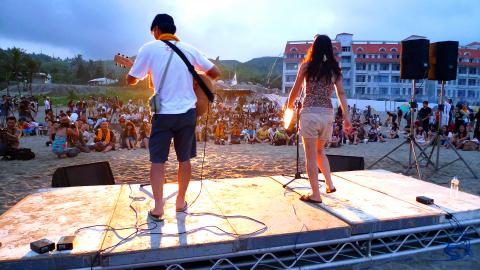Taipei’s oldest rock club, Underworld, closed its rusty metal gate for the last time last Sunday just after midnight to avoid steep government fines. Several hundred people lingered outside in the nearby park for hours longer as part-owner Ho Tung-hung (何東洪) thanked the staff, DJs and others who had helped keep the club running for 16 years. Ho, a professor at Fujen Catholic University, has now expanded the club’s fight towards the creation of a bulletproof legal status for live houses in all of Taiwan. In press conferences and editorials, Ho and other supporters have made repeated calls for Minister of Culture Lung Ying-tai (龍應台) to orchestrate a legal solution. So far, she has responded only through short press releases, expressing vague sympathies but promising no action. So Underworld supporters continue to organize, hold meetings and make creative Facebook posts. There are currently no plans to relocate or re-open.
Meanwhile, a protest concert is brewing in Taitung over a different controversy. The Fudafudak Concert — named after an expletive in the Amis language — will pit a group of Taiwan’s best singers, aboriginal rights activists and environmentalists against the local government and a hideous hotel construction scheme. Alas, it seems Live Wire is becoming a column about musicians against corrupt property developers. Well, here are the details.
Fudafudak will be held on Shanyuan Beach (杉原沙灘) next Saturday, July 28, though all are invited to come camp on the beach from July 21 to 29. In addition to being on one of the area’s prettiest, yellow-sand beaches, the event also draws from Taiwan’s most concentrated pool of aboriginal musicians, several of whom are famous recording artists who live in the area. The female singer Ilid Kaolo (以莉.高露), who used to perform under the name Hsiao Mei (小美), was awarded the Best New Singer in the most recent Golden Melody Awards. And just to be clear, her award was not for Best Aboriginal Singer (though she won that too), it was for best new singer, period. She’ll join a lineup of aboriginal-folk all-stars that includes Panai (巴奈), Kimbo Hu (胡德夫), Takanow (達卡鬧) and Long Ge (龍哥) as well as some very fun Taipei bands like Relax One (輕鬆玩) and the polymath, multicultural rap group Kao Chou Ching (拷秋勤). There will be about 20 acts in all. This will also be an extremely unique chance to see aboriginal musicians playing outdoors, in front of a sizable home crowd and on ground that they consider sacred. Last year’s first Fudafudak drew around 1,000 people, according to the organizer’s estimates. Given the huge aboriginal population in the area, this concert could achieve ritual-type dimensions. And no one would be surprised if singing broke out among the setup crew every night of the week. Best of all, it’s completely free, though donations are requested. It’s a very good cause.

Photo courtesy of Huang Fu-kwei
The concert’s goal is to keep the beach free and open to the public. That means ridding it of a sputtering construction project that has blocked the beach entrance since 2005. The construction of the Miramar Resort Village (美麗灣渡假村) was first approved by local authorities in 2004, and within two years, developers managed to build a five-storey, 250-meter-long hotel complex before ever bothering to apply for an environmental impact assessment. Activists consider the construction to be illegal and say it should be torn down. Aboriginal groups claim the beach to be sacred ground. Their actions have stalled the project, and the High Court has ordered construction to stop on several occasions, most recently in January. In June, however, the Taitung County Government gave developers a new permit to continue building, saying the problems were only “procedural.” Taiwan proper only has about a dozen beaches that are good for tourism. It has already built nuclear power plants on two of them (Fulong and Nanwan), and ten years ago it essentially sold a gorgeous beach inside a national park (Dawan in Kenting) to a sorry excuse for a luxury hotel owned by a steel company (The Chateau). Every person in Taiwan with a shred of conscience is against this Miramar Resort. When will the government figure this crap out?
Shanyuan Beach is located about 6km north of Taitung City on the coastal highway. For concert information, search “Taidong Protest Concert” on Facebook or check: www.gigguide.tw/event-5543.
The Blues Society on Taiwan will host its first ever Blues Cruise next Saturday, and the event features dinner, bands and drinks on a Mississippi-style riverboat on the Tamsui River .

Photo: Chen Hui-ling, Taipei Times
Now, if you get really drunk and try to say “booze cruise,” it may very well come out as “blues cruise.” As in, “I drank fishteen martinis on the blooze cruise, and boy was it aweshome.” We’re pretty sure this is exactly how they intended it, and it’s probably how they came up with the name too.
The performers are the Muddy Basin Ramblers, BoPoMoFo (ㄅㄆㄇㄈ), Blues Vibrations, Shun Kikuta, Mike Mudd, Nick Brown and B.B. Cooky. The four-hour excursion includes a Cajun dinner by Capone’s head chef, W. Hunter DiLeo, and one drink. Tickets were $1,500, but the event is already sold out, begging the question, why are we teasing you with it? Sorry, we’ll try to let you know earlier next time, as this sounds like fun. They even want to people to dress like James T. West, Artemis Gordon and the various femme fatales of The Wild Wild West.
BSoT Blues Cruise, Saturday, July 28 from 5-9pm, at Guandu Wharf (關渡碼頭). Reservations: (02) 2858-5966, or through Capone’s or the Tavern.

Exceptions to the rule are sometimes revealing. For a brief few years, there was an emerging ideological split between the Democratic Progressive Party (DPP) and Chinese Nationalist Party (KMT) that appeared to be pushing the DPP in a direction that would be considered more liberal, and the KMT more conservative. In the previous column, “The KMT-DPP’s bureaucrat-led developmental state” (Dec. 11, page 12), we examined how Taiwan’s democratic system developed, and how both the two main parties largely accepted a similar consensus on how Taiwan should be run domestically and did not split along the left-right lines more familiar in

As I finally slid into the warm embrace of the hot, clifftop pool, it was a serene moment of reflection. The sound of the river reflected off the cave walls, the white of our camping lights reflected off the dark, shimmering surface of the water, and I reflected on how fortunate I was to be here. After all, the beautiful walk through narrow canyons that had brought us here had been inaccessible for five years — and will be again soon. The day had started at the Huisun Forest Area (惠蓀林場), at the end of Nantou County Route 80, north and east

This month the government ordered a one-year block of Xiaohongshu (小紅書) or Rednote, a Chinese social media platform with more than 3 million users in Taiwan. The government pointed to widespread fraud activity on the platform, along with cybersecurity failures. Officials said that they had reached out to the company and asked it to change. However, they received no response. The pro-China parties, the Chinese Nationalist Party (KMT) and Taiwan People’s Party (TPP), immediately swung into action, denouncing the ban as an attack on free speech. This “free speech” claim was then echoed by the People’s Republic of China (PRC),

Specialty sandwiches loaded with the contents of an entire charcuterie board, overflowing with sauces, creams and all manner of creative add-ons, is perhaps one of the biggest global food trends of this year. From London to New York, lines form down the block for mortadella, burrata, pistachio and more stuffed between slices of fresh sourdough, rye or focaccia. To try the trend in Taipei, Munchies Mafia is for sure the spot — could this be the best sandwich in town? Carlos from Spain and Sergio from Mexico opened this spot just seven months ago. The two met working in the